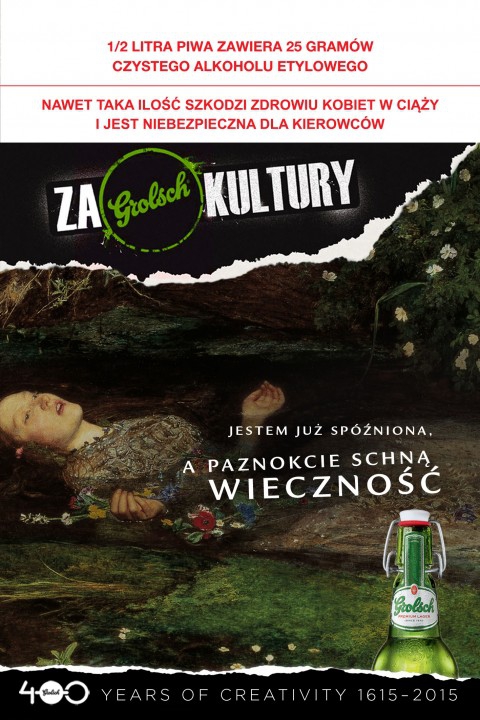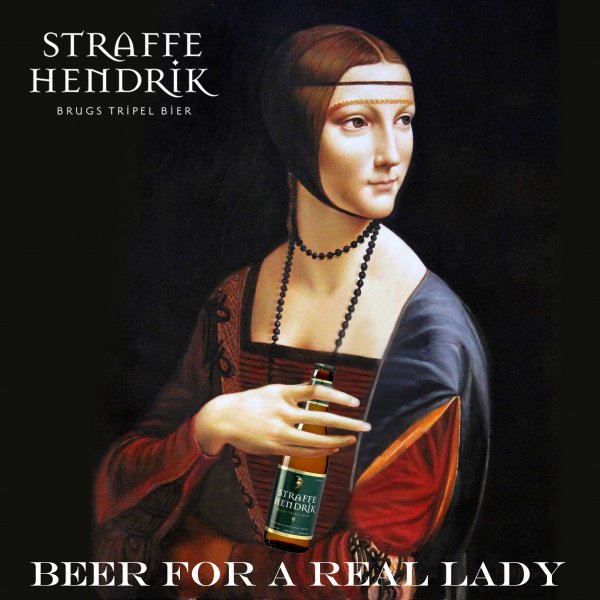“I’m already late and my nail polish still isn’t dry”, „”Welcome to my Instagram”, “Shall I eat or post on FB […]”…; these and some other slogans “complement” works of art in the advertising campaign celebrating the 400th anniversary of the Grolsch brand. Slogans – reminiscent of memes – comment on scenes depicted from the paintings of pre-Raphael’s or the impressionists.

This idea may outrage enthusiasts of fine art for whom classic painting does not necessarily go hand in hand with beer consumption. Irrespective of such controversies and aesthetic issues, we find this advertising a marriage of fine art with beer highly interesting for copyright-related reasons. Since the campaign used masterpieces of classic European painters and combined them with humorous texts, the question arises whether such action is subject to any restrictions from the perspective of copyright law. For example, does it require prior consent, and if it does – whose?
These questions may seem insignificant, but the problem of using works of art in advertising activities has emerged before and has elicited controversy. Owners of certain paintings (mostly museums, galleries) are of the opinion that any use of works of art in commercial activity (including adaptations and any other compilations) requires their consent and the payment of remuneration. Last year one such case involved probably the most valuable work of art in Poland, that is “Lady with the ermine” by Leonardo da Vinci from the 15th century. As is widely known, this painting is currently found in the collection of the Princes Czartoryski Foundation (pol. Fundacja Książąt Czartoryskich).
One Polish graphic designer, in an international competition organized for a Dutch beer brand, altered the “Lady” so that the famous ermine was replaced by a bottle of beer.

Internet users found the work to their liking and awarded it first place disregarding the Foundation. The Foundation, in turn, sent an e-mail to the competition’s organizer indicating (without providing any specific legal basis) that it has “arbitrary power” to decide whether the “photographic reproduction” may be used by third parties and in what nature this use may be (it precluded, for example, beer advertisement). Due to this action by the Foundation, the competition results were voided.
In this context, let’s get back to our question whether as a matter of fact classic works of art are subject to copyright protection and thus whether their use may be restricted.
Despite being created a few centuries ago, such works may be somewhat retroactively deemed works in the meaning of the Copyright Act. As a rule, the right to use a work falls within the scope of proprietary copyrights and is awarded to the author. In the case of adaptations of works, according to Article 2(2) of the Act, performing such adaptations (compilations) does not require the author’s consent, but using such adapted works (e.g. for the purposes of public exhibitions) does. What’s important, however, is proprietary copyrights are not perpetual, and according to the Act expire 70 years after the author’s death or first distribution of the work (if the author is unknown). This time limit also relates to adaptations (compilations) of works (according to Article 2(2) of the Act). In the case of classic works of art, there is no doubt this period expired a long time ago. Therefore, from the perspective of proprietary copyright, using them (including adaptations, compilations) is not subject to any restrictions (i.e. does not require any consent).
We should not forget, however, apart from proprietary copyrights the Act provides for the field of moral copyrights, i.e. special rights that protect “the bond between the author and the work, unlimited in time and independent of any waiver or transfer”, and in other words – the emotional and psychic relation of the author to the effect of their work. Such rights include, among others, the right to inviolability of the form or contents of the work as well as the supervision over its use. In principle, such rights allow the author to oppose, for example, such use of their work that ridicules it, distorts its intentions or the purpose of creation. In the case of the author’s death, such rights may be executed by entities indicated in the Act (including, in particular, heirs). Most importantly, the Act does not list owners of copies of a given work (e.g. museums, galleries) among such entities.
It seems that in the case of such old works the probability of finding relatives entitled to assert claims is close to zero. On the other hand, when it comes to possible claims on the part of other entities indicated in Article 78(4) of the Act, the merits of the claim (or motivations behind it) should be assessed on a case by case basis, depending of the context and purpose in which a given work was used. Moreover, in order to prove the present use of a work (e.g. in an advertisement or for any other commercial purpose) actually infringes moral copyrights, one should reproduce the author’s will related to the creation of this work. In this context, it is not insignificant to note that such works already form a part of canons of culture and have become essentially a “public good”, so using them should not be subject to any restrictions.
The problems, however, do not end here. Irrespective of copyright-related matters, one of the arguments invoked by museums that desire to limit the right to use a given work of art is the property right to a copy of the work. In our opinion, this argumentation is irrelevant. In the case of “Lady with beer instead of the ermine”, the use does not involve a physical copy of the work (in the meaning of “medium”, the material object itself), but the use of the work as such.
Recapitulating – it seems Polish law does not provide effective arguments to prohibit using classic, old works of art even if such use has purely advertising, commercial purpose…
…but irrespective of the legal issues, the lady should remain a lady and shouldn’t post pics with beer on Facebook.
Sources:
(1) http://www.marketing-news.pl/message.php?art=44489
(2)http://www.dobrystan.pl/artykuly/problem-damy-z-gronostajem


